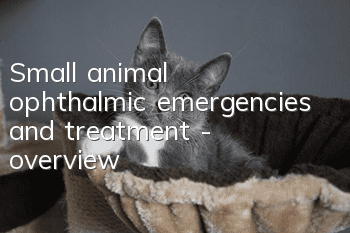Small animal ophthalmic emergencies and treatment - overview

Small animal eye emergencies are often caused by trauma, and some cases are not related to trauma. Often owners will observe clinical signs such as squinting, blinking, photophobia, mucous discharge, and scratching, and appropriate management is very important because small lesions are likely to develop into serious lesions. It is important to inquire about the medical history at the beginning, including breed, age, duration of disease, type of trauma, whether vision is lost, and whether there are other eye diseases and drug use. If the medical history is unclear, for safety reasons, it is recommended that the patient be treated as an emergency.
In addition to observing the appearance, a systematic examination should also be performed from outside the orbit to inside the orbit, and from the front of the eyeball to the back of the eyeball, to evaluate the extent and prognosis of eye injuries. Before conducting an eye examination, the overall condition of the animal should be assessed to see if it is stable. Examinations such as cardiopulmonary function, blood biochemistry, and nervous system should precede vision assessment. In addition to an ophthalmological examination, other examinations, such as an ophthalmic ultrasound, may be performed if necessary to determine the extent of damage to the eye and the tissues surrounding the eye.
Eye examination
1. Routine inspection It is similar to a formal eye examination, but animals are usually aggressive due to pain or loss of vision. Therefore, when the vital signs are stable and the animal is healthy, sedation or general anesthesia can be performed to facilitate the examination; but usually in a dark room Local anesthesia is performed, which is enough to carry out relevant examinations. 2. It is highly suspected that there is eyeball rupture or deep corneal ulcer
A complete examination is not necessary and direct referral to an animal ophthalmologist is recommended. (1) For any eye trauma, a tear test and corneal fluorescein staining should be done first. (2) Corneal staining can show the location, size and depth of the lesion. (3) If the lesion is too deep, there is no need to rush to measure the intraocular pressure to avoid eyeball rupture. (4) Confirm the function of the eyelids. If the eyelids are ischemic and swollen, exposure dry eye syndrome will occur.
Medicine is more valuable than precision, learning is more important than being broad, knowledge is more valuable than excellence, heart is more valuable than emptiness, industry is more valuable than expertise, words are more important than being obvious, Dharma is more valuable than being alive, prescription is more valuable than being pure, treatment is more valuable than skill, and effectiveness is more valuable than quickness. Knowing this, the doctor will be able to complete his work.
——Zhao Lian of the Qing Dynasty, "Preface to the Medical Supplementary Essentials"
Long press the QR code above to follow "Good Veterinary School",
Click "Read original text" below to visit the official website
- How to comfort a cat with irritated fur?
- What is the function of cat meat pads?
- Why is the cat shivering after vaccination? Is it a drug allergy?
- Why do I have soft stool after eating canned Miao Xian Bao?
- Precautions for internal and external deworming of cats
- How does a cat adapt to its new home when it first arrives?
- Cat plague will get better after a few days
- Can cats with autism heal themselves?
- Kitten eating habits: feeding frequency is the key
- Some methods to stop bleeding in cats, it is recommended to collect them!



